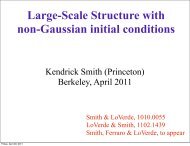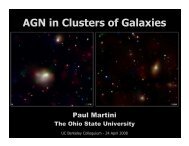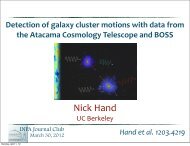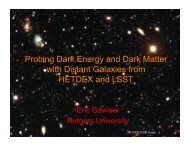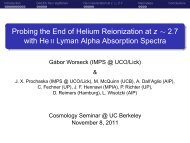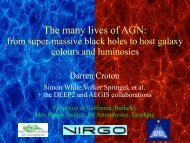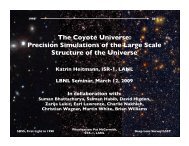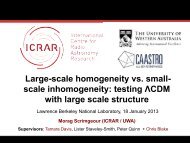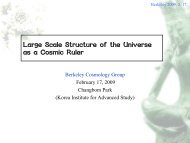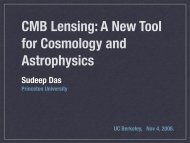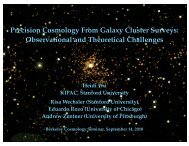CMB polarization: past, present, and future - Berkeley Cosmology ...
CMB polarization: past, present, and future - Berkeley Cosmology ...
CMB polarization: past, present, and future - Berkeley Cosmology ...
You also want an ePaper? Increase the reach of your titles
YUMPU automatically turns print PDFs into web optimized ePapers that Google loves.
<strong>CMB</strong> <strong>polarization</strong>: <strong>past</strong>, <strong>present</strong>, <strong>and</strong> <strong>future</strong><br />
Kendrick Smith<br />
University of Chicago<br />
February 2007, <strong>Berkeley</strong>
Outline<br />
I Overview; what can be learned from <strong>CMB</strong> <strong>polarization</strong>?<br />
II CAPMAP (2003-2007)<br />
III QUIET (2007-)<br />
IV E-B separation
What have we learned from the <strong>CMB</strong> temperature?<br />
Primary <strong>CMB</strong> temperature signal: snapshot of acoustic oscillations<br />
at recombination (z ∼ 1100).
What have we learned from the <strong>CMB</strong> temperature?<br />
1. Angular scale of acoustic peaks:<br />
ℓa = π D∗<br />
s∗<br />
←− Angular diameter distance to recombination<br />
←− Distance sound travels before recombination
What have we learned from the <strong>CMB</strong> temperature?<br />
2. Radiation-matter ratio:<br />
r∗ =<br />
ρr<br />
ρm<br />
<br />
a∗<br />
∝ (Ωmh 2 ) −1
What have we learned from the <strong>CMB</strong> temperature?<br />
3. Photon-baryon ratio:<br />
<br />
3ρb<br />
R∗ =<br />
4ργ<br />
a∗<br />
∝ (Ωbh 2 )
Importance of the <strong>CMB</strong> prior<br />
Hu, Huterer & Smith, ApJL (2006)<br />
<strong>CMB</strong> constraints on<br />
{Ωmh 2 , Ωbh 2 , D∗}<br />
are important for every flavor of<br />
cosmological data!<br />
(Supernova example shown here)<br />
In addition, C TT<br />
ℓ contains information<br />
about the shape of the initial<br />
power spectrum (tilt ns, running α,<br />
etc.)
<strong>CMB</strong> <strong>polarization</strong>: E-B decomposition<br />
<strong>CMB</strong> <strong>polarization</strong> can be decomposed into. . .<br />
E-modes: Πab = ∇a∇b − 1<br />
2 δab∇ 2 φ.<br />
◮ Dominant component: generated by<br />
first-order perturbations at recombination<br />
<strong>and</strong> reionization.<br />
B-modes: Πab = 1<br />
2 ɛa c ∇b∇c + 1<br />
2 ɛb c ∇a∇c<br />
φ.<br />
◮ Generated by second-order effects (mainly<br />
gravitational lensing of the larger E-mode<br />
signal).<br />
◮ Also generated by gravitational waves<br />
from inflation.<br />
This is the spin-2 analogue of the gradient/curl decomposition for<br />
a vector field.
<strong>CMB</strong> <strong>polarization</strong>: E-B decomposition<br />
◮ EE <strong>and</strong> BB power spectra shown,<br />
with noise power spectra for<br />
comparison (θFWHM = 10<br />
arcmin).<br />
◮ Current experiments (∼ 50<br />
µK-arcmin) have detected EE to<br />
10σ, with upper limits on BB.<br />
◮ Future ground-based experiments<br />
(∼ 5 µK-arcmin) should make<br />
precision measurements of EE <strong>and</strong><br />
detect B-modes.
<strong>CMB</strong> <strong>polarization</strong>: acoustic peaks (C EE<br />
ℓ )<br />
In principle, measuring acoustic peaks in C EE<br />
can improve errors<br />
ℓ<br />
on {Ωmh2 , Ωbh2 , D∗} by a factor of ∼ √ 2. However, for<br />
signal-to-noise reasons, C EE<br />
by C TT<br />
ℓ . . .<br />
Lewis Hyatt<br />
ℓ<br />
probably best regarded as predicted<br />
Exception: <strong>polarization</strong> is complementary<br />
to temperature when estimating<br />
the primordial power spectrum<br />
P ζζ (k) (Hu & Okamoto 2003).<br />
Exception: isocurvature modes<br />
(Bucher, Moodley & Turok 2000)
<strong>CMB</strong> <strong>polarization</strong>: gravity waves (C BB<br />
ℓ<br />
at low ℓ)<br />
Low B-mode multipoles ultimately have<br />
more sensitivity to gravity waves in the<br />
early universe (parameterized by tensorto-scalar<br />
ratio T /S) than any other type<br />
of data.<br />
Well-motivated in some inflationary<br />
models; observation would rule out others<br />
(e.g. ekpyrotic).
<strong>CMB</strong> <strong>polarization</strong>: gravitational lensing<br />
“Guaranteed” B-mode signal from<br />
gravitational lensing of the larger Emode<br />
signal.<br />
Probes new parameters, e.g. overall<br />
lensing amplitude depends on mν<br />
by 50% per eV (Eisenstein & Hu<br />
1997)<br />
Gravitational lensing appears in temperature<br />
<strong>and</strong> <strong>polarization</strong>, but <strong>polarization</strong><br />
is more sensitive.<br />
Smith, Hu & Kaplinghat, PRD (2005)
Foregrounds<br />
Bennett et al (2003)<br />
Bolometers (ν ≥ 100 GHz)<br />
BICEP, Clover, EBEX, Spider<br />
Coherent detectors (ν ≤ 90 GHz)<br />
QUIET<br />
Good frequency coverage is essential<br />
for controlling foregrounds
Foregrounds<br />
K1 Polarization Amplitude K1 Polarization Prediction from Haslam<br />
Page et al (2006)<br />
0<br />
T(mK)<br />
0.1<br />
Taken over large regions of sky,<br />
foregrounds are comparable to<br />
or larger than expected <strong>CMB</strong><br />
<strong>polarization</strong> signals<br />
However. . .<br />
To date, polarized foregrounds<br />
have not been a significant<br />
contaminant for ground-based<br />
experiments sampling “clean”<br />
patches of sky.
Part II: CAPMAP<br />
Coherent polarimeters + 7m telescope<br />
(Crawford Hill, NJ)<br />
First (2003, 4 detectors) observing<br />
season resulted in 2σ detection of EE<br />
(Barkats et al 2005)<br />
Second (2005, 16 detectors) observing<br />
season: soon!
CAPMAP: focal plane<br />
Jeff McMahon<br />
12 W-b<strong>and</strong> (90 GHz) detectors + 4 Q-b<strong>and</strong> (40 Ghz) detectors<br />
Scan small patch near NCP<br />
Total sky area: 7.3 deg 2 (90 GHz), 9.2 deg 2 (40 GHz)
CAPMAP: summary<br />
ν Ndet ∆T Area Noise θFWHM<br />
CAPMAP I 90 GHz 4 433 hr 2.0 deg 2 100 µK’ 4’<br />
CAPMAP II 40 GHz 4 900 hr 9.2 deg 2 70 µK’ 6’<br />
90 GHz 12 900 hr 7.3 deg 2 60 µK’ 3.5’<br />
Two independent analysis pipelines:<br />
1. Pipeline 1: re<strong>present</strong> data in real space (θ, φ), noise as dense<br />
covariance matrix (Npix ∼ 2500 for beam size pixels, ∼ 10000<br />
for 1/2 beam size).<br />
2. Pipeline 2: treat noise as azimuthally symmetric <strong>and</strong> Fourier<br />
transform in φ (coordinates are now θ, m); big speedup since<br />
covariance matrices become block diagonal in m (can easily<br />
go to 1/3 beam size)
CAPMAP: analysis pipeline<br />
· · ·<br />
Timestreams (+ pointing)<br />
N −1<br />
map = PN −1<br />
tod PT<br />
−→ −1.5<br />
1<br />
0.5<br />
0<br />
−0.5<br />
−1<br />
−1 −0.5 0 0.5 1 1.5<br />
⎛ ⎞<br />
∗ ∗ · · ·<br />
⎜<br />
⎝ ∗ ∗ · · · ⎟<br />
⎠<br />
.<br />
. . ..<br />
Map + noise covariance<br />
; N −1<br />
mapm = P T N −1<br />
tod t<br />
Timestream noise model: white + marginalization over lowest 5<br />
ring modes + ground-synchronous signal.<br />
(Simulations show that this filter sufficiently removes 1/f noise.)
CAPMAP: analysis pipeline<br />
1<br />
0.5<br />
0<br />
−0.5<br />
−1<br />
−1.5 −1 −0.5 0 0.5 1 1.5<br />
⎛ ⎞<br />
∗ ∗ · · ·<br />
⎜<br />
⎝ ∗ ∗ · · · ⎟<br />
⎠<br />
.<br />
. . ..<br />
Map + noise covariance<br />
−→<br />
Power spectrum likelihood<br />
Likelihood can be explored in different ways (Newton-Raphson,<br />
Markov chain, . . . ) but each “step” requires a dense matrix<br />
operation (Bond, Jaffe & Knox 1997)<br />
Use S/N eigenmode compression to reduce matrix size (N ∼ 2000<br />
independent of pixel size) (Bond 1994)
CAPMAP: Fisher matrix from full analysis pipeline<br />
B<strong>and</strong>power Fisher matrix computed<br />
from noise covariance matrix in real<br />
pipeline (equivalent to MC average of<br />
many simulations).<br />
Pipeline also includes null test suite: difference two maps made<br />
from disjoint data subsets, analyze power spectrum <strong>and</strong> compare<br />
to zero. (When applied to the two frequency channels, this is a<br />
strong test for foregrounds.)
Part III: QUIET (Q/U Imaging ExperimenT)<br />
Atacama desert, Chile<br />
Phase I (late 2007):<br />
2m telescope, ∼ 100 detectors<br />
Phase II (2010):<br />
2m telescope, ∼ 1000 detectors<br />
7m telescope, ∼ 500 detectors
QUIET: “Coherent polarimeter on a chip”<br />
CAPMAP 90GHz polarimeter<br />
→<br />
QUIET 90GHz module
QUIET: Scan strategy<br />
Keith V<strong>and</strong>erlinde<br />
Four patches selected for low<br />
foreground contamination,<br />
distribution around SCP<br />
roughly uniform in RA.<br />
After many repointings, get<br />
roughly isotropic coverage <strong>and</strong><br />
good cross-linking
QUIET: summary<br />
ν Ndet ∆T Area Noise θFWHM<br />
CAPMAP I 90 GHz 4 433 hr 2.0 deg 2 100 µK’ 4’<br />
CAPMAP II 40 GHz 4 900 hr 9.2 deg 2 70 µK’ 6’<br />
90 GHz 12 900 hr 7.3 deg 2 60 µK’ 3.5’<br />
QUIET I 40 GHz 19 4000 hr 1600 deg 2 49 µK’ 10’<br />
90 GHz 83 4000 hr 1600 deg 2 34 µK’ 10’<br />
QUIET II 40 GHz 166 4000 hr 1600 deg 2 9.6 µK’ 10’<br />
(2m) 90 GHz 714 4000 hr 1600 deg 2 7.3 µK’ 10’<br />
QUIET II 40 GHz 83 8000 hr 160 deg 2 3.2 µK’ 6’<br />
(7m) 90 GHz 357 8000 hr 160 deg 2 2.5 µK’ 3.5’<br />
Forecasting methodology: Compute dense matrix at low ℓ<br />
(including scan strategy <strong>and</strong> mode removal); use simple fsky<br />
scaling at high ℓ.
QUIET: phase I forecasts (90 GHz alone)
QUIET: phase II forecasts (90 GHz alone)
QUIET phase I: analysis pipeline<br />
Problem size:<br />
Ntod = (2)(91)(30 Hz)(10 7 sec) = 5.4 × 10 10<br />
Npix = (3)(fsky )(12N 2 side ) = 3.8 × 105<br />
(Nside = 1024)<br />
Unlike CAPMAP, fully optimal analysis seems prohibitive.<br />
Exploring Monte Carlo based alternatives:<br />
◮ Map-making: destriping<br />
◮ Map-making: MASTER approach (high-pass + binning)<br />
◮ Power spectrum estimation: pseudo-Cℓ<br />
Computational cost: probably ∼ 10 4 CPU-hours for a full analysis<br />
Running problem: E-B mixing
Part IV: E-B mixing<br />
How are E-mode <strong>and</strong> B-mode power spectra estimated from data?<br />
◮ Under the simplifying assumption of all-sky isotropic noise,<br />
a E ℓm =<br />
estimating C EE<br />
ℓ , C BB<br />
ℓ from a noisy map Πab is straightforward:<br />
<br />
C EE<br />
ℓ<br />
d 2 x Π ab (x)Y E<br />
(ℓm)ab (x) aB ℓm =<br />
<br />
= 1<br />
2ℓ + 1<br />
ℓ<br />
m=−ℓ<br />
a E ℓm aE∗<br />
ℓm<br />
C BB<br />
ℓ<br />
d 2 x Π ab (x)Y B<br />
(ℓm)ab (x)<br />
= 1<br />
2ℓ + 1<br />
ℓ<br />
m=−ℓ<br />
a B ℓm aB∗<br />
ℓm<br />
◮ The E-mode <strong>and</strong> B-mode spherical harmonics Y E<br />
ℓm (x), Y B<br />
ℓm (x)<br />
provide a complete basis for E-mode <strong>and</strong> B-mode power on<br />
the sky, <strong>and</strong> are decoupled from each other.
What is the E-B mixing problem?<br />
◮ In the presence of sky cuts or inhomogeneous noise, the E/B<br />
decomposition becomes more complicated:<br />
pure E-mode ambiguous mode pure B-mode<br />
◮ Pure E-modes <strong>and</strong> B-modes are expensive to compute directly<br />
◮ Challenge: Find a B-mode estimator which only receives<br />
contributions from pure B-modes, <strong>and</strong> is computationally fast.
Pseudo-Cℓ power spectrum estimation: 1-D analogy<br />
◮ Start with timeseries on a finite interval:<br />
◮ Take FFT, <strong>and</strong> estimate power spectra, as<br />
if the timeseries were periodic on a larger<br />
interval:<br />
f (ω) =<br />
<br />
P(ω) = | f (ω)| 2<br />
dt f (t)W (t) exp(iωt)<br />
◮ Final step: fix up the normalization<br />
P(ω) = 1<br />
K P(ω)
Pseudo-Cℓ power spectrum estimation: 2-D version<br />
◮ Start with <strong>CMB</strong> <strong>polarization</strong> on a finite<br />
patch:<br />
◮ Take spherical transform, <strong>and</strong> estimate<br />
power spectrum, as if the <strong>polarization</strong><br />
were defined all-sky:<br />
a E ℓm =<br />
<br />
C EE<br />
ℓ<br />
Π ab (x)W (x)Y E∗<br />
(ℓm)ab (x) aB ℓm =<br />
<br />
= 1<br />
2ℓ + 1<br />
C EE<br />
ℓ<br />
C BB<br />
ℓ<br />
ℓ<br />
m=−ℓ<br />
◮ Final step: debias<br />
+<br />
K<br />
= ℓℓ ′<br />
K −<br />
ℓℓ ′<br />
a E ℓm aE∗<br />
ℓm<br />
K −<br />
ℓℓ ′<br />
K +<br />
ℓℓ ′<br />
C BB<br />
ℓ<br />
Π ab (x)W (x)Y B∗<br />
(ℓm)ab (x)<br />
= 1<br />
2ℓ + 1<br />
ℓ<br />
m=−ℓ<br />
a B ℓm aB∗<br />
ℓm<br />
<br />
−1 C EE<br />
ℓ ′ − 〈 C EE<br />
ℓ ′ 〉noise<br />
C BB<br />
ℓ ′ − 〈 C BB<br />
ℓ ′ <br />
〉noise
Pseudo-Cℓ power spectrum estimation: tradeoffs<br />
◮ Pseudo-Cℓ: suboptimal but very fast<br />
◮ Practial problem: how to choose pixel weight function W (x)?<br />
◮ For B-modes, there is a more fundamental problem: the<br />
estimator mixes E <strong>and</strong> B <strong>and</strong> therefore limits B-mode<br />
sensitivity at low noise levels.<br />
a B ℓm =<br />
<br />
Π ab (x)W (x)Y B<br />
(ℓm)ab (x)
Pseudo-Cℓ power spectrum estimation: EB mixing<br />
Smith (2005)<br />
C EE<br />
ℓ<br />
C BB<br />
ℓ<br />
+<br />
K<br />
= ℓℓ ′<br />
K −<br />
ℓℓ ′<br />
K −<br />
ℓℓ ′<br />
K +<br />
ℓℓ ′<br />
◮ Challinor & Chon (2004): For<br />
fsky ∼ 0.01, pseudo-Cℓ limits the<br />
gravity wave signal which can be<br />
detected to (T /S) ∼ 0.05.<br />
◮ In the pseudo-Cℓ method, E → B<br />
mixing is treated like noise: can<br />
subtract bias, but extra variance<br />
remains.<br />
<br />
−1 C EE<br />
ℓ ′ − 〈 C EE<br />
ℓ ′ 〉noise<br />
C BB<br />
ℓ ′ − 〈 C BB<br />
ℓ ′ <br />
〉noise
A “pure” pseudo-Cℓ estimator:<br />
Proposal: Add higher-spin weights Wa, Wab <strong>and</strong> counterterms to<br />
cancel the E-B mixing (Smith 2005)<br />
a B ℓm =<br />
<br />
d 2 x Π ab <br />
(x) W (x)Y B∗<br />
(ℓm)ab<br />
Wb(x)Y G∗<br />
c (ℓm)c<br />
+ Wc(x)Y G∗<br />
(ℓm)b<br />
+ɛa <br />
(ℓ − 1)(ℓ + 2)<br />
ɛa<br />
+<br />
cWbc(x)Y ∗ <br />
ℓm<br />
(ℓ − 1)ℓ(ℓ + 1)(ℓ + 2)<br />
Also proposed algorithmic approach for choosing W (x), Wa(x),<br />
Wab(x) (Smith <strong>and</strong> Zaldarriaga 2006).<br />
Based on variational principle: minimize “average power” 〈 Cℓ〉<br />
satisfying normalization constraint <br />
x W (x) = 1.
Pure pseudo-Cℓ estimator: EB mixing<br />
Smith (2005)
Fiducial experiment: hitcount map<br />
◮ Fiducial experiment: average noise ∼ 5.75 µK-arcmin,<br />
θFWHM = 8 arcmin, r<strong>and</strong>omly generated point source mask,<br />
noise distribution based on preliminary EBEX simulations.<br />
12.04 ΜKarcmin 6.02 5.25 4.72 4.32 4.01 3.76 3.55
Fiducial experiment: weight functions<br />
◮ Optimized weight function depends on ℓ b<strong>and</strong>; shown here for<br />
(ℓmin, ℓmax) = (30, 70) (top row) <strong>and</strong> (510, 550) (bottom).<br />
◮ Each “weight function” consists of four pieces (left to right):<br />
E-mode weight function WE (x), scalar piece of B-mode<br />
weight W (x), <strong>and</strong> two B-mode counterterms Wa(x), Wab(x).
Fiducial experiment: power spectrum errors<br />
Smith & Zaldarriaga, astro-ph/0610059<br />
◮ Adding counterterms significantly improves BB power<br />
spectrum errors for the fiducial experiment<br />
◮ Gravity wave signal: σ(T /S) 0.054 → 0.0056.<br />
◮ Lensing amplitude: σ(Alens) 0.258 → 0.085.
Concluding thoughts<br />
Estimator gives good E-B separation while also solving an<br />
outst<strong>and</strong>ing practical problem: choosing the weight function.<br />
Estimator performance seems convincing for “real-world”<br />
distribution of white noise, but full QUIET noise model will be<br />
more complicated (1/f noise, ground synchronous modes. . . )<br />
Related: this only solves half the EB separation problem for Monte<br />
Carlo <strong>CMB</strong> pipelines!<br />
Map-making also mixes E <strong>and</strong> B. . .
Concluding thoughts
Acknowledgements<br />
“Theory”<br />
Wayne Hu<br />
Dragan Huterer<br />
Manoj Kaplinghat<br />
Matias Zaldarriaga<br />
CAPMAP<br />
Princeton: Suzanne Staggs, Denis<br />
Barkats, Phil Farese, Lewis Hyatt, Jeff<br />
McMahon, Glen Nixon<br />
Chicago: Bruce Winstein, Colin<br />
Bischoff, Matt Hedman, Dorothea<br />
Samtleben, Keith V<strong>and</strong>erlinde<br />
JPL: Todd Gaier<br />
Miami: Josh Gundersen<br />
QUIET<br />
Chicago: Bruce Winstein, Colin Bischoff,<br />
Mircea Bogdan, Alison Brizius, Dan Kapner,<br />
Keith V<strong>and</strong>erlinde<br />
Bonn: Dorothea Samtleben<br />
Columbia: Amber Miller, Robert Dumoulin,<br />
Laura Newbergh, Ross Williamson<br />
Caltech: Tim Pearson, Martin Shepherd, Tony<br />
Readhead, Joey Richards<br />
JPL: Todd Gaier, Kris Gorski, Charles Lawrence,<br />
Mike Seiffert, Clive Dickinson, Ian O’Dwyer,<br />
Erik Leitch<br />
Miami: Josh Gundersen, Eugenia Stefenescu<br />
Oxford: Pedro Ferreira, Mike Jones, Angela<br />
Taylor<br />
Princeton: Suzanne Staggs, Glen Nixon<br />
Stanford: Sarah Church, Keith Thompson




